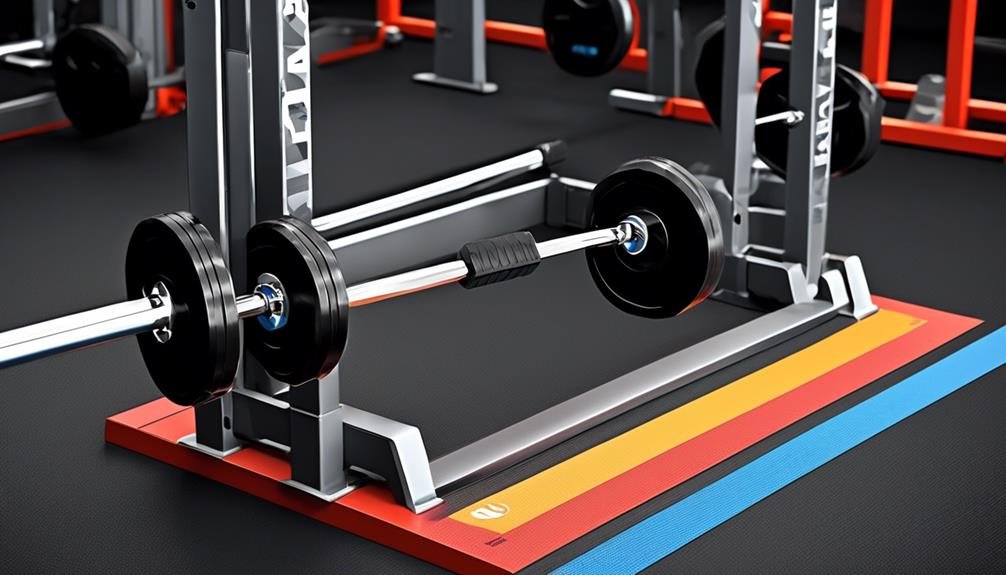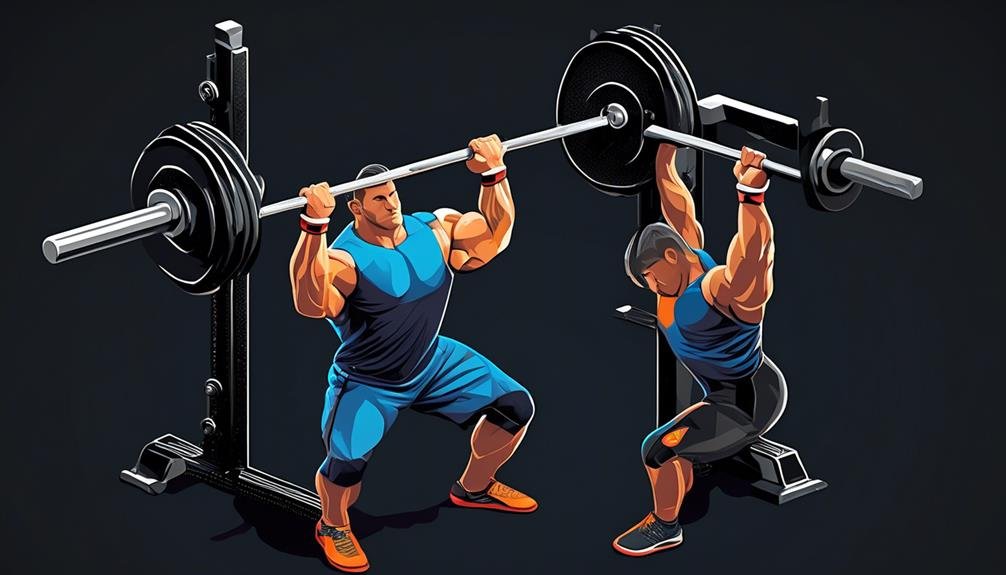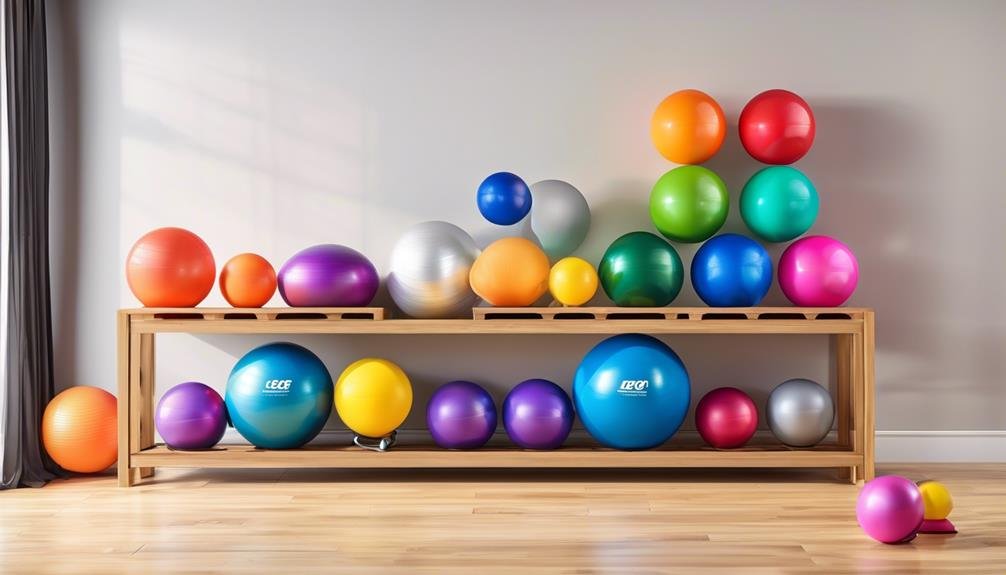When it comes to embarking on the journey of weightlifting, it's crucial to familiarize yourself with the proper way to navigate the loading and unloading process of a barbell. Ensuring your safety and optimizing your performance are paramount, and understanding the correct techniques will be instrumental in your success.
But what exactly is the proper way to load and unload a barbell? How can you ensure that you're doing it right?
Well, my friend, buckle up because we're about to unveil the secrets that will make all the difference in your weightlifting journey. So, grab a seat (or stand, if you prefer) and get ready to learn the ins and outs of barbell loading and unloading.
Key Takeaways
- Start with a stable and level surface for proper barbell loading and unloading.
- Choose plates with appropriate diameter for proper barbell height and alignment.
- Position the barbell correctly on the squat rack or floor for optimal performance and safety.
- Ensure the barbell is balanced and stable by adding weight plates symmetrically and using collars to secure them.
Safety First: Understanding the Importance of Proper Barbell Loading and Unloading
To ensure the safety of yourself and others, it's crucial to understand and prioritize proper barbell loading and unloading techniques.
When loading a barbell, always start with a stable and level surface. Position the barbell parallel to the floor, ensuring that the weight plates are evenly distributed on both sides. Use collars or clips to secure the weight plates in place, preventing them from sliding off during the lift.
When unloading the barbell, take care to remove the collars first, followed by the weight plates in a controlled manner. Avoid letting the weights drop or slide off the barbell, as this can cause injury to you or those around you.
Remember to always start with lighter weights and gradually increase the load as you become more comfortable and confident with the movement.
Choosing the Right Weights: Selecting the Appropriate Plates for Your Lifts
When selecting the appropriate plates for your lifts, it's essential to consider the weight distribution and stability that you established during the barbell loading process. The right weights can significantly impact your performance and minimize the risk of injury.
To begin, you must determine the total weight you want to lift. This includes the weight of the barbell itself and the additional plates. The weight plates you choose should be evenly distributed on each side of the barbell to maintain balance. It's crucial to select plates with the appropriate diameter to ensure proper barbell height and alignment. Different lifts may require different plate combinations, so it's essential to have a variety of weights available.
Additionally, consider the material and quality of the plates. Cast iron plates are durable and long-lasting, while bumper plates are designed for Olympic lifts and provide added protection to the barbell and floor.
Positioning the Barbell: Placing the Barbell Correctly on the Squat Rack or Floor

Properly positioning the barbell is crucial for executing lifts correctly and safely. Whether you're placing the barbell on a squat rack or on the floor, it's important to follow the correct procedures to ensure optimal performance and minimize the risk of injury.
Here are some guidelines to help you position the barbell correctly:
- Squat Rack Placement:
- Position the barbell at a height that allows you to unrack it comfortably without straining your shoulders or back.
- Ensure that the barbell is evenly centered on the rack, with the knurling facing towards you for a better grip.
- Floor Placement:
- Align the barbell parallel to your body and perpendicular to your feet.
- Place the barbell on a stable surface, such as a weightlifting platform or rubber mat, to prevent it from rolling or slipping during the lift.
Loading the Barbell: Step-By-Step Instructions for Adding Weights Safely
Add weight to the barbell safely by following these step-by-step instructions.
Loading the barbell correctly is crucial for maintaining balance and stability during your lifts. To begin, ensure that the barbell is properly positioned on the squat rack or on the floor, as discussed in the previous section.
Once the barbell is in position, stand in front of it with your feet shoulder-width apart. Grasp the barbell with an overhand grip, keeping your hands slightly wider than shoulder-width apart. Lift the barbell off the rack or floor, using your legs to generate power and maintain a strong core. With the barbell in your hands, carefully align it with your upper chest or collarbone, making sure it sits securely on your shoulders.
Now, it's time to add weight plates to the barbell. Start by selecting the desired weight plates and placing them on the floor beside the barbell. Squat down and pick up the weight plates, one at a time, using a neutral grip. Align each plate with the barbell sleeves and slide them onto the bar, ensuring they're securely fastened. Repeat this process until you have added the desired amount of weight to the barbell. Remember to check that the plates are evenly distributed on both sides of the barbell to maintain balance.
Once you have finished loading the barbell, double-check that all plates are securely fastened before attempting your lifts. By following these step-by-step instructions, you can safely add weight to the barbell and set yourself up for successful lifts.
Centering the Weight: Ensuring the Barbell Is Balanced and Stable

To ensure the barbell is balanced and stable, it's essential to properly distribute the weight plates on both sides of the bar, maintaining equilibrium for safe and effective lifts. Achieving centering of the weight is crucial to prevent any imbalances that could lead to injury or hinder your performance. Here are key steps to follow:
- Start with an empty barbell:
Begin by placing an empty barbell on the squat rack or on the ground, ensuring it's level and stable.
- Add weight plates symmetrically:
Choose the appropriate weight plates and place them on both sides of the barbell simultaneously. This ensures equal distribution of the load and helps to maintain balance during lifts.
- Place the larger plates on the inside:
Position the larger weight plates closest to the center of the barbell. This arrangement helps to bring the center of mass closer to your body, enhancing stability.
- Use collars to secure the plates:
Once the weight plates are in position, secure them with collars to prevent any shifting or sliding during your lifts.
Unloading the Barbell: Proper Techniques for Removing Weights Without Compromising Form
When unloading the barbell, it's important to follow proper techniques to remove weights without compromising your form. To begin, make sure that you have a clear space to work in and that your surroundings are safe.
Start by removing the smaller plates first, working your way up to the larger ones. This allows for better balance and reduces the risk of injury. When removing the weights, always maintain a stable grip on the barbell to prevent it from tipping or falling.
Use your legs and hips to generate force and lift the weights off the barbell. Keep your back straight and engage your core muscles to maintain proper posture throughout the unloading process.
As you remove each weight, carefully place it on the weight rack or designated storage area. Take your time and avoid rushing, as haste can lead to accidents or strain.
Storing the Plates: Tips for Organizing and Storing Your Weights After Your Workout

For efficient organization and storage of your weights after a workout, it's important to implement proper techniques and strategies. Here are some tips to help you organize and store your weights effectively:
- Keep similar weights together: Grouping plates of the same weight together will make it easier for you to find and use them in future workouts. This can be done by using weight plate racks or shelves specifically designed for weight storage.
- Label your weights: Consider labeling your weights with their corresponding weight values. This will save you time and effort when selecting the appropriate weights for your exercises.
- Utilize storage solutions: Invest in storage solutions such as weight plate trees or storage racks that can hold your weight plates securely and keep them off the floor. This won't only help you maintain a neat and organized workout space, but it will also prevent any potential damage to your weights.
- Consider weight plate storage bags: Weight plate storage bags are a convenient option for those who've limited space or need to transport their weights. These bags provide a compact and easy-to-carry solution for storing your weight plates.
Maintenance and Care: Keeping Your Barbell in Top Shape for Optimal Performance
To maintain optimal performance and prolong the lifespan of your barbell, it's essential to implement proper maintenance and care practices. By following these guidelines, you can ensure that your barbell remains in top shape for optimal performance during your lifts.
First and foremost, it's crucial to keep your barbell clean and free from dirt and debris. After each use, wipe the barbell down with a clean, dry cloth to remove any sweat or chalk residue. This will prevent rust and corrosion from forming on the bar.
Additionally, it's important to store your barbell properly. Avoid leaving it on the floor or leaning it against a wall, as this can cause unnecessary stress on the barbell. Instead, invest in a sturdy barbell rack or wall mount to keep your barbell secure and protected when not in use.
Regularly inspect your barbell for any signs of wear and tear. Check for loose or damaged parts, such as the collars or sleeves. If you notice any issues, promptly address them to prevent further damage and ensure your safety during lifts.
Frequently Asked Questions
How Do I Know if the Barbell Is Properly Balanced Before Starting My Lifts?
Before starting your lifts, ensure the barbell is properly balanced by checking that the weight plates are evenly distributed on both sides. This will help maintain stability and reduce the risk of injury during your workout.
Are There Any Specific Safety Precautions I Should Take When Loading and Unloading the Barbell?
When loading and unloading a barbell, it is crucial to prioritize safety. Always ensure the plates are secure and evenly distributed. Use collars to prevent plates from sliding. Take caution to avoid injury.
Can I Use Different Types of Plates (E.G. Bumper Plates, Iron Plates) for Loading the Barbell?
Yes, you can use different types of plates, such as bumper plates or iron plates, for loading the barbell. However, it is important to ensure that the plates are securely fastened to prevent any accidents or injuries during your lifts.
Is There a Specific Order in Which I Should Load and Unload the Weights on the Barbell?
When it comes to loading and unloading a barbell, it is important to follow a specific order. This ensures proper weight distribution and reduces the risk of injury. Let's discuss the correct sequence.
How Often Should I Check the Condition of My Barbell and Weights for Any Signs of Wear and Tear?
You should regularly check the condition of your barbell and weights for signs of wear and tear. This is important to ensure your safety and the longevity of your equipment.
Conclusion
In conclusion, proper barbell loading and unloading is crucial for safety and optimal performance during lifts.
By understanding the importance of safety, choosing the right weights, positioning the barbell correctly, and following step-by-step instructions for loading and unloading, you can ensure a balanced and stable barbell.
Additionally, organizing and storing your weights properly, as well as regularly maintaining and caring for your barbell, will help to prolong its lifespan and maintain its optimal performance.





